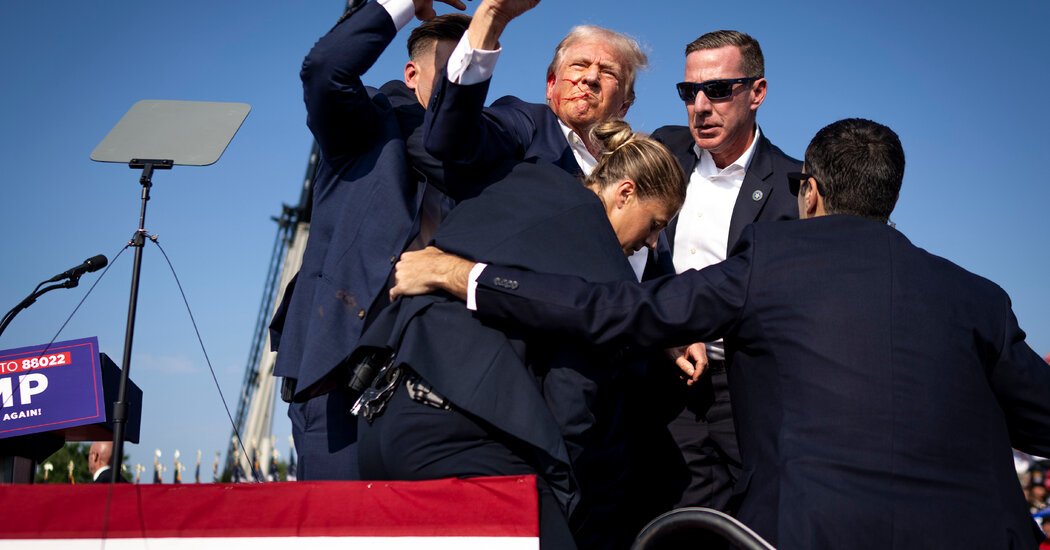If we had seen the attack on former President Donald J. Trump only through television footage, it would have appeared shocking, but also chaotic and muddled. The candidate dives to the rostrum after an assassin’s bullet grazes his ear. Secret Service agents jump in. He gets back on his feet, gestures to the crowd and is rushed out to cheers.
The still images of the assassination attempt — by Doug Mills of The New York Times, and by photographers from The Associated Press and Reuters — tell another story. Blood running from Mr. Trump’s ear to his lips testifies to how close the former president had come to death. His raised fist offers a highly legible refusal to capitulate. To the television cameras, everything was pandemonium. In the lens of the still camera, the horror of the attack was translated into embodiments of authority, defiance and near martyrdom.
I understand the tendency to hunt for visual analogies when extraordinary events like this take place. The American flag billowing behind Mr. Trump’s bloodied face in some of the photos may superficially recall a Romantic tradition of bloodied national heroes, real or allegorical. A reverse image bot without much horse power could easily match them to Eugène Delacroix’s “Liberty Leading the People” (1830), in which a woman embodying France raises a flag in her right arm, or John Singleton Copley’s “Death of Major Peirson” (1782—84), a history painting of a victorious general dying beneath the British flag. The triangular formation of Secret Service agents seems to have put quite a few people in mind of the photo of the flag being raised at Iwo Jima.
People like these visual analogues because they offer a pedigree to news imagery. They promise to assign distinction to outliers in our perpetual image stream, and to inscribe the past in the present. But as a moral matter, I have always bridled against the temptation to treat images of suffering (two people are dead, and Mr. Trump and two others are injured) as objects of aesthetic judgment. And analogies like these underestimate a larger change in how we encounter images today, where even the most “iconic” picture is something mutable and unfixed.
The video footage captured the chaos in real time: Mr. Trump on the ground for a full minute, not rising until the Secret Service shouts “We’re clear, we’re clear.” (As agents try to hustle Mr. Trump away, a microphone catches him asking about getting his shoes; an agent advises him to hold something to his bleeding head.) Then he stops, pausing to raise and pump his fist — once considered a left-wing gesture, a symbol of Communist resistance or Black Power. At the distance of the television cameras, the fist functioned like the thumbs-up sign that injured football players flash for live television, a made-for-TV expression of survival.
But to the still camera, the fist had a more warlike aspect, suggesting fearlessness and indomitability. The photos say “I am safe; I am strong,” but more powerfully they say “I know I must look like I am safe; I know I must look like I am strong.”
The force of the photographs, in other words, rests not in what they depict politically but what they convey about political depiction, which Mr. Trump seems to understand better than any other political figure of his day. After two weeks when the incumbent president has been in the spotlight for his appearance of frailty, Mr. Trump had the instinct, amid mortal danger, to consider how everything would look.
Images traveled slowly when Presidents Lincoln and Garfield were shot in the 19th century, when it fell to illustrators to depict, or confect, what happened to the assassinated head of state. When Presidents Ford and Reagan faced attempts on their lives in the 20th century, sending images via wire still required cumbersome portable transmitters. Now the digital camera is its own broadcast medium, and each image it produces can become an unmoored vector of advocacy, opposition, propaganda and lulz.
Mr. Trump’s bloodied face and raised fist may appear on the cover of Time, but the magazine’s circulation is dwarfed by the shares and reposts that have already propelled these images worldwide. On my smartphone, the news photographs quickly became memes in shockingly bad taste (the bloodied ear becoming, for example, a reaction to hearing the new Katy Perry album) even before the originals had reached the television screen. The image of authority also invites its own parody; that is the secret of its strength.
The 45th (and would-be 47th) president’s deepest admirers have often portrayed him as a superman. In memes and merchandise he has posed as an all-conquering hero, far removed from the reality of the debate stage or the defendant’s box. By Sunday afternoon Mr. Trump’s campaign had blasted out a fund-raising email featuring a retouched version of one of these new vitalist icons — the color altered to grayscale, and with added noise to suggest an older photograph. A historic image? There is no history anymore, only the perpetual present of content, which Mr. Trump understands even amid gunfire.
Read More: The Photographs That Made Trump an Incarnation of Defiance


